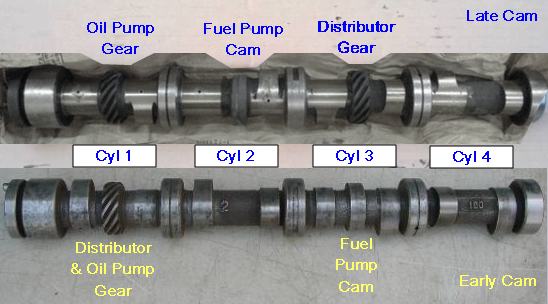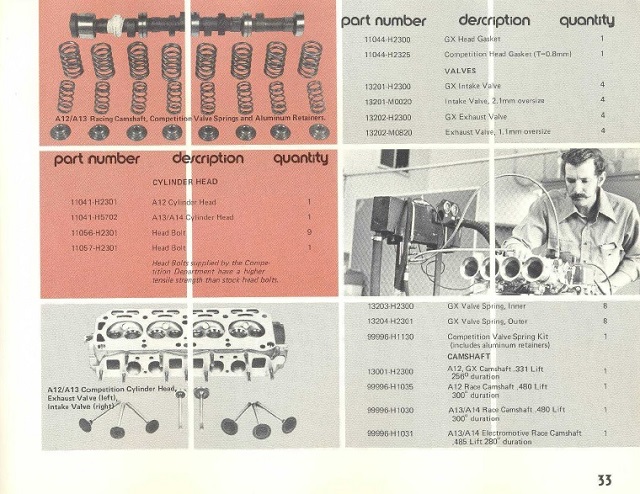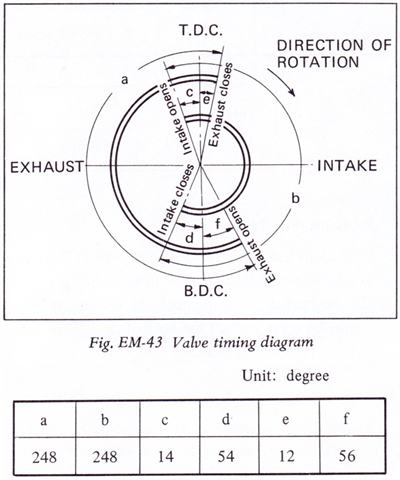There are basically five factory camshaft grinds, from A10 to performance grinds.
Contents |
Overview
There are basically five factory camshaft grinds:
* 1000cc grind (180) * small bore grind (H10/H70/H50) * large bore grind (H62) * Performance grind for A12GX, A12T, A14T, EFI (H23/H57) * Hi-torque emission grind (H98)
However, these can be fitted to any engine. The emission grind cam was used in A12A, A14 and A15 engine -- all with same cam part number.
240/240 duration (A10 Datsun 1000) 248/248 duration (standard small bore) 248/256 duration (standard large bore) 256/256 duration (performance engines) 244/248 duration (Late emission)
| Cam: | A10 (B10) | A12 (1973 USA) | A12GX |
| Part: | 13001-18000 | 13001-H1000 | 13001-H2300 |
| HP: | 62hp@6000rpm | 69hp@6000rpm | 83hp@6400rpm |
| Torque: | 61.5 lb-ft | 10.0kg-m@4,400rpm | 9.7kg-m@3,600rpm |
| Exhaust open duration: | 240° | 248° | 256° |
| Intake open duration: | 240° | 248° | 256° |
| Intake opens at: | 12° | 14° BTDC | 20° BTDC |
| Intake closes at: | 48° | 54° ABDC | 56° ABDC |
| Exhaust opens at: | 50° | 56° BBDC | 58° BBDC |
| Exhaust closes at: | 10° | 12° ATDC | 18° ATDC |
| Lift: | ? | 8mm | 8.4mm |
Identification
Nissan Competition cams were stamped on the end. Most aftermarket cams are also stamped there.

A10 cams are cast "180" or other numbers
Early 1200 cast "H10" or other numbers
Late 1200 cams are cast "H50" or other numbers


Aftermarket cams use a Nissan blank, and regrinds use a stock cam.

Stock factory A12T cam in Nismo packaging:

Duration
"Advertised Duration" means you should only compare these numbers with grinds from the same manufacturer. Other vendors may measure it differently.
Nissan POST may measure the duration at 0.020 inch lift. Many aftermarket companies measure it at 0.050 inch lift.
Engine Size
Engine displacement doesn't matter. In certain years, all A12 A14 and A15 engines were fitted with the *same* camshaft.
For example:
1982 B310 USA Part Number 13001-H9800 CAMSHAFT A12A, A14, A15 1981-up IN: 244, EX: 248
However, in other years and markets different specs were used. For example:
1982 B310 CANADA: A12A Part Number 13001-H5000 CAMSHAFT A12A CAN IN: 248, EX: 248 A15 Part Number 13001-H9800 CAMSHAFT A14 CAN IN: 244, EX: 248
Early vs. Late
For 1974, the A-series engine was re-designed. Because the distributor moved from beside cylinder #1 to beside cylinder #3, a new gear was added to the cam. The Fuel pump eccentric was moved from #3 to #2 at the same time. (In the Older version, the oil pump gear also was used for the distributor)
Top: July 1974-up camshaft

Bottom: 1967-1973 June camshaft
1974-up
- 13001-H9800 CAMSHAFT [Typical use: 1981-1982 USA, A15 worldwide 1981-]
- 244/248 duration
- USA B310 A14,A15 B310 0880-
- USA B310 A12A 0880- B310
- 13001-H5700 CAMSHAFT [Typical use: Performance engine]
- 248/256 duration .331 lift
- JPN B210 A12T, A14T
- JPN B310 A14E, A15E
- 13001-H5000 CAMSHAFT [Typical use: A12S]
- 248/248 duration
- JPN B120 A12S
- JPN B210 A12S
- JPN B310 A12S, A13S
- USA B310 A12A 0879-0780
- CAN B310 A12A
- 13001-H6200 ASSY-CAMSHAFT [Typical use: A14/A15]
- 248/256 duration
- JPN B210 A14S
- USA B210 A13, A14
- USA B210 F10 A14
- USA B310 A14,A15 -0780
- JPN B310 A14S, A15S
ADVERTISED DURATION 248/248 duration (standard small bore) * 13001-H5000/ 248/256 duration (standard large bore) * 13001-H6200 256/256 duration (performance engines) * 13001-H5700 .331 lift 244/248 duration (Late USA emission) * 13001-H9800
1967-1973
13001-H7000 ASSY-CAMSHAFT USA B110 A12 0772- 0 13001-H2300 13001-H2300 CAMSHAFT B110 JPN A12 GX 13001-H1000 CAMSHAFT B110 USA JPN A12 13001-18001 CAMSHAFT B10 JPN A10 0470- * replaces 13001-18000 & 13001-H0100 13001-18000 CAMSHAFT JPN B10 A10 13001-H0100 CAMSHAFT JPN B10 A10
ADVERTISED DURATION 240/240 duration (A10 Datsun 1000) * 13001-H18001 248/248 duration * 13001-H1000 A12 256/256 duration .331 lift * 13001-H2300 A12 GX
A15 Cam
If you have a 1979-1980 A15 it has the good camshaft. If it pulls hard to 6000 RPM, you have the good one. If it falls off at 5000, it has the mild cam.
A15 1979-1980 from B310 Sunny: 6000 RPM camshaft A15 1983-up worldwide (Vanette): Mild camshaft A15 1981-1982 North America-spec: Mild camshaft A15 industrial: Very mild camshaft
If you have a Vanette A15, put in the A14 camshaft, it will wake up the A15.
Competition Camshaft
Beware, some cams have no eccentric cam for the fuel pump. You will have to use an electric fuel pump with these cams.
Top: Tomei 80A competition cam

Bottom: 1974-up factory cam
Nissan Competition Parts
1984 Nissan Competition Catalog
 |
[see below] |
CAMSHAFTS & RELATED COMPONENTS (A-SERIES) PART NO. DESCRIPTION QTY REQ. * 13001-H2300 GX CAMSHAFT (.331"/256°) source: A12 GX Engine stock part For use in A-series engines built up to 6/73. Requires only new lifters for installation. * 13001-H5700 GX CAMSHAFT (.331"/256°) source: Japan-market B210 A12T stock, B310 A14E stock 20/62/65/35/12/15 lift 8.4, clearance .35 For use in A-series engines built up to 6/73. Requires only new lifters for installation. * 13001-H5710 70° camshaft 280° 38/62/65/35/12/15 lift 9.4, clearance .25 recommended for rallies limit RPM 7600, normal RPM 7200 * 13001-H5711 74° camshaft 296° 46/70/73/43/12/15 lift 9.4, clearance .25 recommended for gymkhanas limit RPM 7800, normal RPM 7400 * 13001-H5712 80° camshaft 320° 58/82/85/55/12/15 lift 10.5, clearance .25 recommended for racing limit RPM 8500, normal RPM 8000 * 13001-H5713 82° camshaft 328° 62/86/62/55/12/12 lift 10.5, clearance .25 * 99996-H1030 Electramovive race camshaft .480 lift 300 duration * 99996-H1031 ELECTRAMOTIVE RACE CAMSHAFT #1 .468"/300° cam is ground on 104° lobe centers. Requires use of competition valve springs, retainers and new 13231-78201 lifters * 99996-H1032 ELECTRAMOTIVE RACE CAMSHAFT #2 .468"/310° Except for 310° duration all specifications and installation requirements are the same as 99996-H1031. * 99996-H1035 A12 race camshaft .480 lift 300 duration * 13001-5741 CAMSHAFT BILLET
* 13231-78201 OVERSIZE CAM FOLLOWER Required when installing either of the Electramotive race camshafts * 99996-H1132 COMPETITION VALVE SPRING This inner and outer spring assy should have an installed height of 1.61" and a seat pressure of 130 lbs/in. Requires the use of 99996-H1131. * 99996-H1131 ALUMINUM VALVE SPRING RETAINER Requires use of 99996-H1132.
Specs
B310 cam specs


Aftermarket Grinds
Build the rest of the engine first, the camshaft should be the last thing to be selected.Yes indeed. The camshaft profile should match the breathing characteristics of the engine -- meaning induction/carburetion, cylinder head, and exhaust system. The cam will not change how those engine parts work, it can only assist them (or detract from them).
Some cams are marketed as "RV" cams which are lower HP than stock, they are designed for lower RPM cruising and short shifting.
Beware that many cams purchased actually make less usable horsepower for the way people drive. Most popular aftermarket cams are higher duration, they don't work as well until higher RPMs where indeed they are superior. As does the stock cam -- if you don't like to rev it up, you should replace it with a mild cam so it makes more HP at the RPMs where you drive. Like a stock A12A cam would do in an A15. Which is what Datsun did for the 1980s A-series engines.
Finally there are high-lift, quick-open cams which can improve HP at lower, mid and high speed without necessarily shifting the powerband into higher RPMs. These can be really agressive on roller cam engines -- far more than 1970s hot cams. Unfortunately A-series is not favorable for a roller cam (the journals are too small). Even so, cam vendors can do some high-lift and quick-opening magic for A-series but they can be noiser and wear faster.
Call your cam vendor and ask for their advice. Tell them what RPM you will be running at and where you want to shift, and whether you care if the valvetrain last 5 years or 5 weeks. Iskenderian is a favorite custom grinder for Datsuns, but most any cam company can do similar. You send in a spare or the original, they grind a new cam lobe pattern and send it back. For a really advanced cam they might need to weld it up to grind the profile on it. The extra dollars can be worth it.
Regrind or New Grind
Regrinds are cheap and effective. The cam grinder takes your existing cam and grinds a new profile on it. As you might guess, the lift will be slightly lower than stock lift or the shaft can be undercut to enable lift increases. The profile can be milder (for increased low RPM power) or wilder (for increase high-RPM power). This is also an inexpensive way to repair a damaged (rusty or worn) cam. As little as $50 USD.
More performance choices are possible by using a new camshaft "blank" (an unmachined camshaft casting). This primarily allows high-lift profiles while keeping the base circle large. Unfortunately cam blanks are around $250 USD -- before the $50 grinding costs.
70
Some cams are marked "70" or similarly on the end. This apparently refers to Intake Opening spec.
No. 140 Tighe Cams Intake Opens & Closes @ degrees 70 37 Fast road [upper spec]
Nissan Competition "70" cam, the 70 may refer to 7000 RPM peak power
70° camshaft 280° 38/62/65/35/12/15 lift 9.4, clearance .25 recommended for rallies limit RPM 7600, normal RPM 7200
Lumpy Cam
Impress your friends with the "rump rump rump" sound that the hairy-chested camshaft causes. High-duration cam profiles, intended for high-RPM operation, cause an inefficient idle. So take your pick: smooth idle with 6400 RPM peak power, or rough idle but with 7000 RPM (or more) peak power.
Seriously, the cylinder head and carburetor are key to high-RPM power. The cam allows those component to work. If you put a high-duration cam in your stock engine, it will sound "lumpy" and will make less power than the stock cam.
Mild Cam
What is a "mild cam" anyhow? It's any camshaft less extreme than some other cam ... in other words it depends on the speaker. Some use the term "mild cam" to refer to a cam which is hotter than the stock cam, but not as wild as a racing cam. Or maybe they are thinking of a "mild" cam as any with a smooth idle.
With the rise of aftermarket cam grinders in the 1950s, stock cams were low-RPM units. Ford, GM and Chrysler V8 engines only revved to 4500 RPM or so, so in those days even a mild cam profile could make huge gains. By contrast, the A-series revs to 6000 RPM with the stock cam profile. Later Nissan came out with a mild 5600 RPM cam for use with A14/A15 round-port engines.
Generally speaking, a "wild" cam is for high-RPM use and has a poor idle quality. A "mild" cam is for low-RPM use such as trailer towing or fuel economy. Be aware that "mild" is also used in contrast to "racing" cams as in "milder than a full race cam". So the term "mild" doesn't mean much except in comparison to some other cam.
Too big of a cam profile can be worse than a small one.
Rule of thumb: A stock or near-stock engine buildup will make less HP when fitted with a wild cam. It calls for a milder cam, like the stock 6000 RPM cam. The stock cylinder head makes less power when revved above 6000-6400 RPM, so choose an appropriate cam profile. An aftermarket high-lift cam with agressive opening and closing event may make more HP at 6000 RPM even though it has a steady idle.
Compression Ratio
High compression will increase horsepower regardless of the camshaft profile. Going from the stock 9:1 Compression Ratio to 10:2 is good for about 3% increase.
With "wild" (lumpy) cams, it is suggested that the CR be raised. This is because the lump cam leaks airflow at low RPMs, loosing power -- and the CR bump is intended to regain that lost power. However it is not required -- with stock compression a lumpy cam on an engine with ported cylinder head and large carburetors will still make more HP (at high RPMs) than stock.
Isky
Iskenderian grinds
Tighe
http://www.tighecams.com.au/cars.htm
No. Timing Advert @.050 Lift Lash 405C 56 12 14 54 248/248 .325 .014/.012 Standard 102 60 20 20 60 260/260 206/206 .390 .012/.010 Torque 113 65 25 25 65 270/270 207/207 .400 .012/.010 Mild road 154 71 25 31 70 276/281 216/222 .400 .012/.010 Fast road 140 70 37 37 71 287/288 240/240 .448 .014/.014 Fast road 150A 71 40 40 71 287/287 240/240 .474 .014/.014 Twin carbs. required 911 76 38 40 74 294/294 248/248 .520 .012/.010 Special valve springs 439C 84 48 50 82 312/312 252/252 .442 .014/.012 Fast road 392C 80 40 44 76 300/300 257/257 .502 .018/.016 Road race only 108 413 85 41 45 81 306/306 260/260 .435 .014/.012 Road race only 503C 90 50 56 85 320/320 .490 .012/.012 Road race only
http://www.tighecams.com.au/profiles3/nissana12.htm

JTS
Camtech
Camtech #618 239/231 RPM RANGE 2000-6000 #639 254/254 RPM RANGE 2400-6400 #621 260/264 RPM RANGE 2600-6800 #609 277/284 RPM RANGE 3200-7200 #608 290/295 RPM RANGE 4000-7800 #604 301/310 RPM RANGE 4400-8200
JUN Auto Works
JUN Auto Works

JUN high-lift camshafts 1004M-N001 68/272 duration/advertised duration 1004M-N002 72/288 1004M-N003 74/296 6.5 lift 1004M-N004 74/296 7.2 lift 1004M-N005 76/304 1004M-N006 80/320 1004M-N007 82/328
Auckland Cams
Auckland Cams sample grinds 157a 188/188 standard grind 157 188/196 Smooth idle Mini-stock 10 202/206 Good idle increased low RPM power 563 212/203 Good idle increase midrange, needs exhaust changes 561 221/221 Moderate idle increase midrange with springs & carb 53 224/224 Slightly lopey 3000-6500 RPM 59 234/234 Lopey idle 3500-6800 RPM 566 239/239 Lopey idle 4000-7000 RPM 158 243/243 Slightly rough idle 4000-7500 RPM 618 259/259 Rough idle 5000-8500 RPM
Wade Cams
Profile, Duration, lift #112 208 .411 Smooth idle, good torque 2000 - 5000 #104 212 .408 Smooth idle, good torque Mild porting, extractors #113 212 .379 Good idle, needs exhaust, low to midrange #240 220 .407 Needs springs, twin carbs, good midrange #446 228 .425 Increased midrange, needs springs 3000-6500 #1009a 230 .464 Needs springs, carbs, suit speedway #140 238 .432 Twin Weber carbs, springs 4000-7000 #176c 243 .470 Top end power, full mods 4000-7500
Chart
| Part Number | @ | Ex. Dur | In. Dur | In. Open | In. Close | Ex. Close | Ex. Open | Lift (in) | Reference |
| 13001-18000 | ? | 240 | 240 | 12 | 48 | 10 | 50 | 29111 | |
| 13001-H1000 | ? | 248 | 248 | 14 | 54 | 12 | 56 | 0.335 | photo |
| 13001-H2300 | ? | 256 | 256 | 20 | 56 | 18 | 58 | 0.353 | A12GX |
| 13001-H5000 | ? | 248 | 248 | 14 | 54 | 12 | 56 | photo | |
| 13001-H5700 | ? | 256 | 248 | 14 | 54 | 20 | 56 | 0.331 | here |
| 13001-H6200 | ? | 256 | 248 | 14 | 54 | 20 | 56 | 0.324 | photo |
| 13001-H9800 | ? | 248 | 244 | 14 | 50 | 12 | 56 | 1981 | |
| 99996-H1031 | ? | 300 | 0.487 | Nismo | |||||
| 99996-H1032 | ? | 310 | 0.487 | Nismo | |||||
| 13001-H5710 | 0.10 | 280 | 38 | 62 | 35 | 65 | 0.37 | topic | |
| 13001-H5711 | 0.10 | 0.37 | Nismo | ||||||
| ? | 0.10 | 320 | 0.413 | Nismo | |||||
| ? | 0.10 | 328 | 0.413 | Nismo |

![[Datsun 1200 encyclopedia]](/wiki/upload/wiki.png)





















